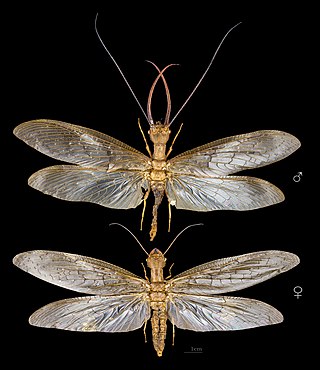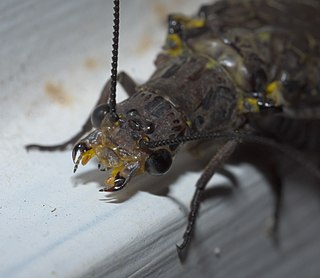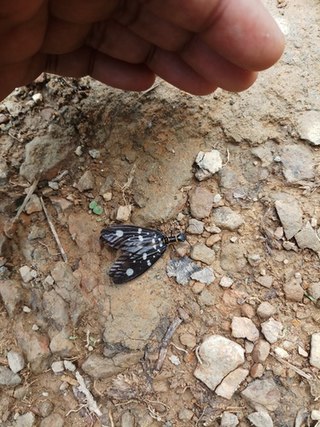
The insect order Neuroptera, or net-winged insects, includes the lacewings, mantidflies, antlions, and their relatives. The order consists of some 6,000 species. Neuroptera is grouped together with the Megaloptera and Raphidioptera (snakeflies) in the unranked taxon Neuropterida.

Megaloptera is an order of insects. It contains the alderflies, dobsonflies and fishflies, and there are about 300 known species.

Fishflies are members of the subfamily Chauliodinae, belonging to the megalopteran family Corydalidae. They are most easily distinguished from their closest relatives, dobsonflies, by the jaws (mandibles) and antennae. In contrast to the large jaws of dobsonflies, fishfly mandibles are not particularly noticeable or distinctive, and the males have feathery antennae similar to many large moths. Chauliodes pectinicornis, the "summer fishfly", is a well-known species in North America.

Hemerobiidae is a family of Neuropteran insects commonly known as brown lacewings, comprising about 500 species in 28 genera. Most are yellow to dark brown, but some species are green. They are small; most have forewings 4–10 mm long. These insects differ from the somewhat similar Chrysopidae not only by the usual coloring but also by the wing venation: hemerobiids differ from chrysopids in having numerous long veins and forked costal cross veins. Some genera are widespread, but most are restricted to a single biogeographical realm. Some species have reduced wings to the degree that they are flightless. Imagines (adults) of subfamily Drepanepteryginae mimic dead leaves. Hemerobiid larvae are usually less hairy than chrysopid larvae.

The family Corydalidae contains the megalopterous insects known as dobsonflies and fishflies. Making up about one dozen genera, they occur primarily throughout the Northern Hemisphere, both temperate and tropical, and South America.

Centuria Insectorum is a 1763 taxonomic work by Carl Linnaeus, and defended as a thesis by Boas Johansson; which of the two men should for taxonomic purposes be credited with its authorship has been the subject of some controversy. It includes descriptions of 102 new insect and crustacean species that had been sent to Linnaeus from British America, Suriname, Java and other locations. Most of the new names included in Centuria Insectorum are still in use, although a few have been sunk into synonymy, and one was the result of a hoax: a common brimstone butterfly with spots painted on was described as the new "species" Papilio ecclipsis.
In the 10th edition of Systema Naturae, Carl Linnaeus classified the arthropods, including insects, arachnids and crustaceans, among his class "Insecta". Insects with net-veined wings were brought together under the name Neuroptera.

Chrysoperla is a genus of common green lacewings in the neuropteran family Chrysopidae. Therein they belong to the Chrysopini, the largest tribe of subfamily Chrysopinae. Their larvae are predatory and feed on aphids, and members of this genus have been used in biological pest control.

Anoplius is a genus of spider wasps in the family Pompilidae, called the blue-black spider wasps.

Nigronia serricornis has many common names including hellgrammites or fishflies or saw-combed fishflies. The genus Nigronia has one other North American member N. fasciatus and South American which lives in much of the same territory and is quite similar in all regards. They are holometabolous insects with an aquatic larval stage. N. serricornis is a common inhabitant of woodland streams in North America and they are often the largest insect predator found in 2nd and 3rd order streams. The larvae are a sit-and -wait ambush predators that feed on a large variety of invertebrates. Studies have shown that N. serricornis has a varying diet throughout the seasons.

Neohermes concolor is a species of fishfly in the family Corydalidae. It is found in North America.

Hemerobius humulinus is a species of brown lacewing in the family Hemerobiidae. It is found in Europe and Northern Asia, North America, and Southern Asia.

Hemerobiinae is a subfamily of brown lacewings in the family Hemerobiidae. There are about 5 genera and at least 60 described species in Hemerobiinae.
Neohermes angusticollis is a species of fishfly in the family Corydalidae. It is found in North America.

Chauliodes rastricornis, the spring fishfly, is a species of fishfly in the family Corydalidae. It is found in North America.

Chauliodes is a genus of fishflies in the family Corydalidae. There are about five described species in Chauliodes.

Neohermes filicornis is a species of fishfly in the family Corydalidae. It is found in North America.

Taeniochauliodes is a genus of fishflies in the family Corydalidae.

Parachauliodes is a genus of fishfly in the family Corydalidae. They are present throughout Eastern Asia, likely originating on the Korean peninsula before dispersing to the Japanese archipelago 15 mya.

Neurhermes is a genus of dobsonflies in the family Corydalidae.

















